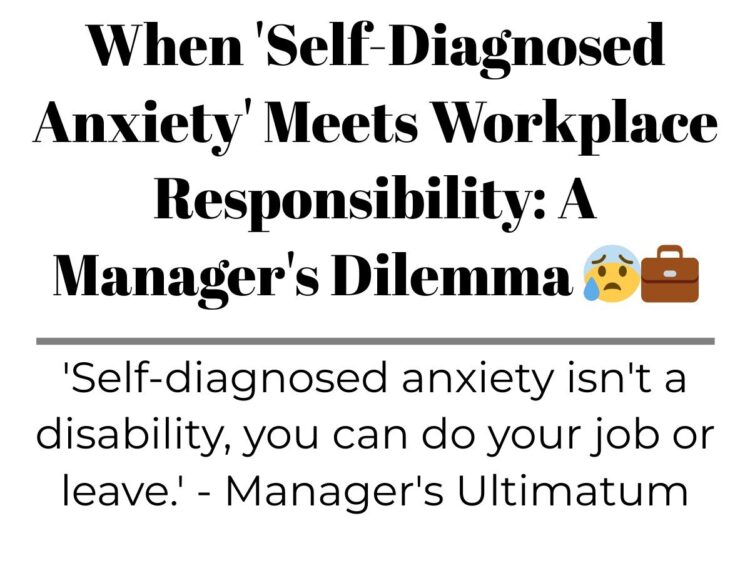Picture this: You’re managing a small, local business with a close-knit team of 9 employees. Everything runs smoothly, until one employee starts to avoid her duties, citing ‘self-diagnosed anxiety’ as the reason. As the boss, what do you do? Do you accommodate, or do you draw a line? This is the predicament one manager found themselves in, and the fallout is something to behold. Let’s dive into the drama.
Setting the Stage: A Small Business with Big Responsibilities

The Cleaning Duty Dilemma

Enter the Reluctant Cleaner ♀️

The Anxiety Excuse?

The Break Room Showdown

The Manager’s Ultimatum ⏰

The Walkout and Threats ♀️

Social Media Backlash

The Aftermath: Employees Divided ♂️ ♀️

The Manager’s Dilemma ♂️

A Clash of Duties and ‘Disabilities’: Who’s the Real Villain Here?
In a whirlwind of workplace drama, a manager finds themselves at odds with an employee who claims her ‘self-diagnosed anxiety’ prevents her from performing her duties. After a tense confrontation, the employee quits, threatens a lawsuit, and takes to social media to air her grievances. The fallout leaves the team divided, with some fearing potential business loss and others upset at the manager’s handling of the situation. As the dust settles, the manager is left to question: Was he too harsh, or was he simply upholding workplace responsibility? Let’s see what the world wide web has to say about this… ️
NTA. Employee’s refusal to perform job duties due to anxiety.
![Image credit: [deleted] | [deleted]](https://static.diply.com/90217961-9e2d-4507-82eb-9b19b9eff379.png)
NTA. Employee’s responsibility to seek treatment, not avoid job responsibilities.
![Image credit: [deleted] | [deleted]](https://static.diply.com/007b8c12-d9ce-4e48-aef8-f971d59831b3.png)
NTA. Reasonable accommodations are necessary, but not excessive workload.

NTA. Self-diagnosis isn’t diagnosis. Employer shouldn’t pay for non-work time.

NTA; Employee wants to lay down in a dark room? Clock out, rest, then clock back in.
![Image credit: [deleted] | [deleted]](https://static.diply.com/25a67cfb-07ab-4626-997a-a532881da8a6.png)
“Allergic to the thing I don’t want to do”

NTA. Accommodating self-diagnosed anxiety can undermine those with actual diagnoses.

NTA. ADA requires reasonable accommodations, but not exemption from cleaning.

Fair enforcement of workplace rules, but paperwork for ADA/FMLA needed.

Documentation won’t change her behavior, she needs a plan

Cleaning the bathroom and taking out the trash: a**hole or NAH?

“NTA. I have Generalized Anxiety along with PTSD (due to a surgery that went badly), and the smell of rubbing alcohol can give me bad flashbacks. I also worked in a place that had touchscreen computers and we used rubbing alcohol to clean them properly. I always carried a small essential oil roll-on in my pocket, so that when it was my turn to clean the computers, I would swipe the roll on under my nose. This temporarily blocked the scent of rubbing alcohol, so I could do my job properly. I’m sympathetic to anxiety, but this is part of her job. If she provided a doctor’s note that not only said she has anxiety/panic attacks and needs some accommodation, as well as maybe why it causes panic attacks/ recommendations for her job (may be she got jumped one time taking out the garbage for example), it would make things a lot easier for both of you. You sound like you are willing to accommodate her- you just don’t know what you need to accommodate, exactly.”

NTA. Manager handled situation appropriately with understanding and consideration.

Calling out BS: Manager vs. ‘Self-Diagnosed Anxiety’

Manager’s failure to proactively handle employee’s health condition
![Image credit: [deleted] | [deleted]](https://static.diply.com/8c83ccb3-b6aa-43d6-9baf-5e63d1194b3a.png)
Employees complain but won’t pick up slack.

NTA. Reasonable accommodations provided, but is it going too far?

“NTA. Coworker used anxiety to avoid tasks. Boss should’ve done same.”

NTA but approach differently. Fake disability, cut hours, document everything

NTA, if she consistently cannot perform her job duties then leave

Autistic employee manages overwhelm at work with understanding colleagues.

NTA. Employee with disability shares frustrations and suggests legal action.

NTA: No diagnosis, no job.


















































